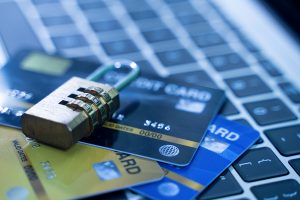Credit and Debit Card Fraud

Globally, credit and debit card fraud leads to $21.84 billion in losses annually. On average, card issuers bear 72% of those losses, and unfortunately, the United States experiences a disproportionate number of losses. Although the U.S. processes just 22.9% of the world’s total credit and debit card transactions, it suffers 38.7% of the world’s fraud losses.
You can interpret these numbers in a range of ways, but if you run a financial institution in America and you issue credit or debit cards, there’s one key takeaway — you need to be prepared for all types of credit and debit card fraud, including the following.
Stolen Cards
If someone steals your customer’s credit or debit cards, they can potentially rack up thousands of dollars in purchases really quickly. Often, there’s no way to recoup the funds, and depending on when your customer notifies you about the theft, you may be liable for some of the charges. Merchants have safeguards in place to prevent this type of credit card fraud, such as requiring users to enter their zip codes when purchasing gas. But unfortunately, that’s often not enough to stop fraud, especially when the thief has your customer’s entire wallet and a lot of their personal details.
Card-Not-Present Fraud
Luckily, since the rise of EMV chips, debit card fraud from stolen cards has fallen, but card-not-present fraud has increased. Card-not-present fraud occurs when a scammer takes the details of your customer’s card and makes purchases online or through catalogs. While merchants have a few tools in place to prevent this type of fraud, the onus falls on financial institutions to protect itself and its customers. Unfortunately, that can be tricky because your customers want to make purchases easily. To balance that, you need machine learning tools in place that get to know your client’s habits and detect fraud accurately.
Identity Theft
With credit and debit card fraud, identity theft falls into two main categories: account takeover and application fraud. Account takeover goes far beyond just stealing a credit card or its numbers. Instead, the fraudster takes over the entire account. To give you an example, imagine a senior has a credit card that they haven’t used in a while. Their caretaker or relative poses as the senior, sets up an online account, changes the address on file, and orders a new card.
However, the thief certainly doesn’t have to know the victim. They can get information from dumpster diving, mail theft, or on the dark web. Similarly, with application fraud, the thief also steals the victim’s personal details, but they use that information to open a whole new account.
Phishing, Smishing, Vishing, and Pharming
Phishing, smishing, vishing, and pharming may be fun to say, but all these activities can spell major trouble for your bank and your customers. As you probably know, phishing is when a scam artist tries to trick your customers into sharing personal information such as credit card numbers or details that the scammer can use to commit identity theft. Smishing is when that process happens over text, vishing occurs on the phone, and pharming involves luring your customers to websites where their information can be stolen.
For instance, a pharming fraudster might send your customer an email claiming that fraud was detected on the account. The email might contain a link along with instructions to enter their card number along with their PIN or other personal details. Because the email and the website look like they’re from you, your customer follows the prompts, inadvertently allowing the fraudster to steal all the information they have entered.
Electronic Pickpocketing
Credit and debit cards that work for “tap”, or contactless pay, have small RFID (radio frequency identification) chips in them, and with the right tools, pickpockets can steal the information from these cards. Luckily, the risk isn’t that significant. Fraudsters tend to focus on the most profitable types of theft, and because the vast majority of Americans don’t have RFID-enabled cards, thieves may have to target dozens of victims before they get a hit. Additionally, your customers can block these attempts with the right bag or even by wearing jeans with pockets made of RFID-blocking materials.
As they say “knowing is half the battle”, but the other half is protecting yourself from these threats. To do that, you need the right fraud protection partner. At SQN Banking Systems, we offer comprehensive fraud detection solutions to safeguard your bank against credit and debit card fraud as well as a wide range of other risks. To learn more, contact us today.
